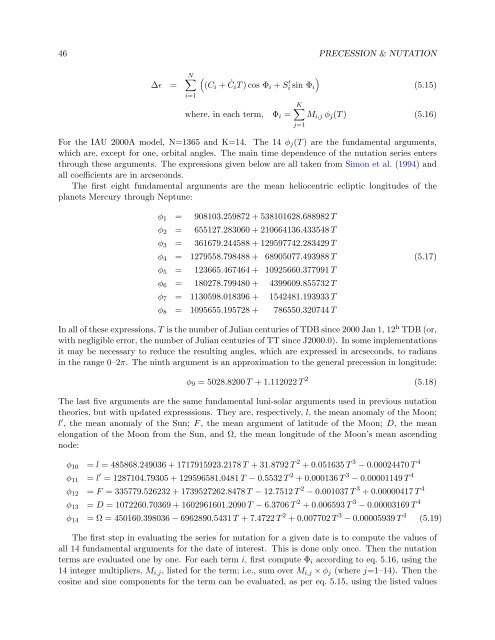USNO Circular 179 - U.S. Naval Observatory
USNO Circular 179 - U.S. Naval Observatory
USNO Circular 179 - U.S. Naval Observatory
You also want an ePaper? Increase the reach of your titles
YUMPU automatically turns print PDFs into web optimized ePapers that Google loves.
46 PRECESSION & NUTATION<br />
∆ɛ =<br />
N<br />
i=1<br />
<br />
(Ci + ˙ CiT ) cos Φi + S ′ <br />
i sin Φi<br />
where, in each term, Φi =<br />
(5.15)<br />
K<br />
Mi,j φj(T ) (5.16)<br />
For the IAU 2000A model, N=1365 and K=14. The 14 φj(T ) are the fundamental arguments,<br />
which are, except for one, orbital angles. The main time dependence of the nutation series enters<br />
through these arguments. The expressions given below are all taken from Simon et al. (1994) and<br />
all coefficients are in arcseconds.<br />
The first eight fundamental arguments are the mean heliocentric ecliptic longitudes of the<br />
planets Mercury through Neptune:<br />
j=1<br />
φ1 = 908103.259872 + 538101628.688982 T<br />
φ2 = 655127.283060 + 210664136.433548 T<br />
φ3 = 361679.244588 + 129597742.283429 T<br />
φ4 = 1279558.798488 + 68905077.493988 T (5.17)<br />
φ5 = 123665.467464 + 10925660.377991 T<br />
φ6 = 180278.799480 + 4399609.855732 T<br />
φ7 = 1130598.018396 + 1542481.193933 T<br />
φ8 = 1095655.195728 + 786550.320744 T<br />
In all of these expressions, T is the number of Julian centuries of TDB since 2000 Jan 1, 12 h TDB (or,<br />
with negligible error, the number of Julian centuries of TT since J2000.0). In some implementations<br />
it may be necessary to reduce the resulting angles, which are expressed in arcseconds, to radians<br />
in the range 0–2π. The ninth argument is an approximation to the general precession in longitude:<br />
φ9 = 5028.8200 T + 1.112022 T 2<br />
(5.18)<br />
The last five arguments are the same fundamental luni-solar arguments used in previous nutation<br />
theories, but with updated expresssions. They are, respectively, l, the mean anomaly of the Moon;<br />
l ′ , the mean anomaly of the Sun; F , the mean argument of latitude of the Moon; D, the mean<br />
elongation of the Moon from the Sun, and Ω, the mean longitude of the Moon’s mean ascending<br />
node:<br />
φ10 = l = 485868.249036 + 17<strong>179</strong>15923.2178 T + 31.8792 T 2 + 0.051635 T 3 − 0.00024470 T 4<br />
φ11 = l ′ = 1287104.79305 + 129596581.0481 T − 0.5532 T 2 + 0.000136 T 3 − 0.00001149 T 4<br />
φ12 = F = 335779.526232 + 1739527262.8478 T − 12.7512 T 2 − 0.001037 T 3 + 0.00000417 T 4<br />
φ13 = D = 1072260.70369 + 1602961601.2090 T − 6.3706 T 2 + 0.006593 T 3 − 0.00003169 T 4<br />
φ14 = Ω = 450160.398036 − 6962890.5431 T + 7.4722 T 2 + 0.007702 T 3 − 0.00005939 T 4<br />
The first step in evaluating the series for nutation for a given date is to compute the values of<br />
all 14 fundamental arguments for the date of interest. This is done only once. Then the nutation<br />
terms are evaluated one by one. For each term i, first compute Φi according to eq. 5.16, using the<br />
14 integer multipliers, Mi,j, listed for the term; i.e., sum over Mi,j × φj (where j=1–14). Then the<br />
cosine and sine components for the term can be evaluated, as per eq. 5.15, using the listed values<br />
(5.19)


